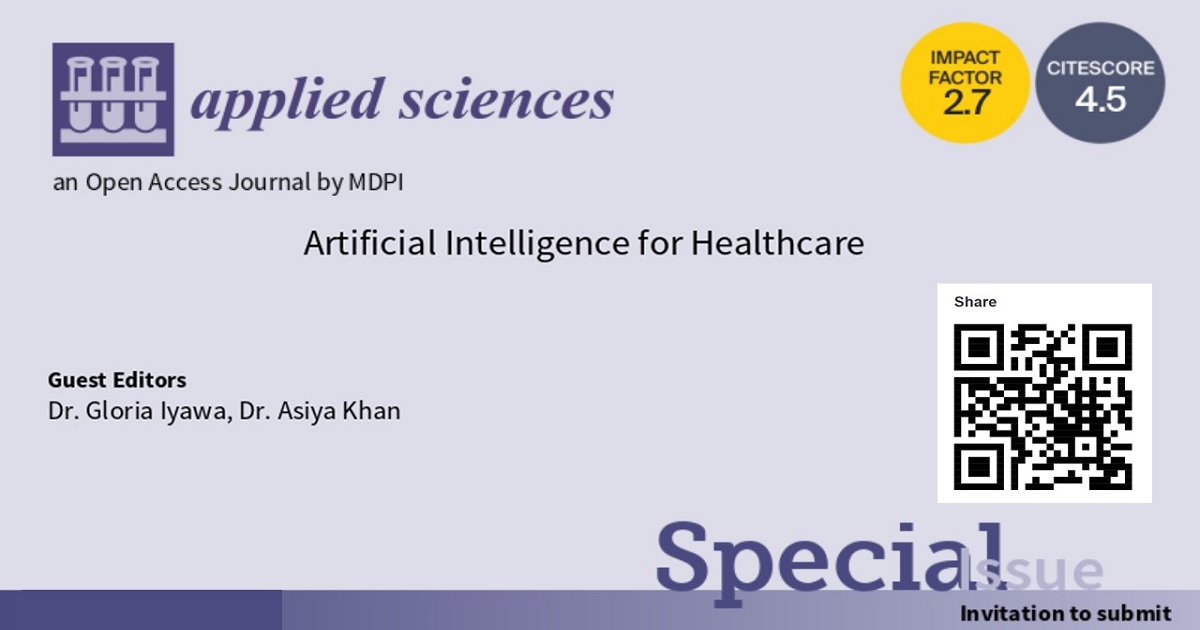Artificial Intelligence for Healthcare
A special issue of Applied Sciences (ISSN 2076-3417). This special issue belongs to the section "Computing and Artificial Intelligence".
Deadline for manuscript submissions: 20 December 2024 | Viewed by 9496

Special Issue Editors
Interests: digital health; artificial intelligence
Special Issues, Collections and Topics in MDPI journals
Interests: prediction and control of video quality using AI, ML, cloud computing, fuzzy logic, applying computer vision techniques, and deep learning in pedestrian recognition; disease identification in cotton crops and damage recognition in wind turbines
Special Issues, Collections and Topics in MDPI journals
Special Issue Information
Dear Colleagues,
Artificial Intelligence (AI) has significantly reshaped healthcare. AI algorithms have been helpful in analysing large datasets, which has resulted in successful outcomes such as making clinical decisions, interpreting medical images and predicting clinical outcomes. Despite the successes of AI in healthcare, there are challenges that exist in the field. These challenges include trust issues, bias in datasets, regulation and lack of evidence in clinical settings.
In this Special Issue, the aim is to publish high-quality articles and reviews that address the challenges of AI in healthcare in the following areas (but not limited to):
- Machine learning;
- Computer vision;
- Deep learning;
- Neural networks;
- Natural language processing;
- Robotics;
- Computational and data science;
- Fuzzy logic;
- Remote monitoring using AI techniques;
- Medical imaging;
- Responsible AI;
- Drug discovery using AI techniques;
- AI implementations in clinical settings.
Dr. Gloria Iyawa
Dr. Asiya Khan
Guest Editors
Manuscript Submission Information
Manuscripts should be submitted online at www.mdpi.com by registering and logging in to this website. Once you are registered, click here to go to the submission form. Manuscripts can be submitted until the deadline. All submissions that pass pre-check are peer-reviewed. Accepted papers will be published continuously in the journal (as soon as accepted) and will be listed together on the special issue website. Research articles, review articles as well as short communications are invited. For planned papers, a title and short abstract (about 100 words) can be sent to the Editorial Office for announcement on this website.
Submitted manuscripts should not have been published previously, nor be under consideration for publication elsewhere (except conference proceedings papers). All manuscripts are thoroughly refereed through a single-blind peer-review process. A guide for authors and other relevant information for submission of manuscripts is available on the Instructions for Authors page. Applied Sciences is an international peer-reviewed open access semimonthly journal published by MDPI.
Please visit the Instructions for Authors page before submitting a manuscript. The Article Processing Charge (APC) for publication in this open access journal is 2400 CHF (Swiss Francs). Submitted papers should be well formatted and use good English. Authors may use MDPI's English editing service prior to publication or during author revisions.
Keywords
- digital health
- artificial intelligence
- machine learning
- responsible AI
Benefits of Publishing in a Special Issue
- Ease of navigation: Grouping papers by topic helps scholars navigate broad scope journals more efficiently.
- Greater discoverability: Special Issues support the reach and impact of scientific research. Articles in Special Issues are more discoverable and cited more frequently.
- Expansion of research network: Special Issues facilitate connections among authors, fostering scientific collaborations.
- External promotion: Articles in Special Issues are often promoted through the journal's social media, increasing their visibility.
- e-Book format: Special Issues with more than 10 articles can be published as dedicated e-books, ensuring wide and rapid dissemination.
Further information on MDPI's Special Issue polices can be found here.






